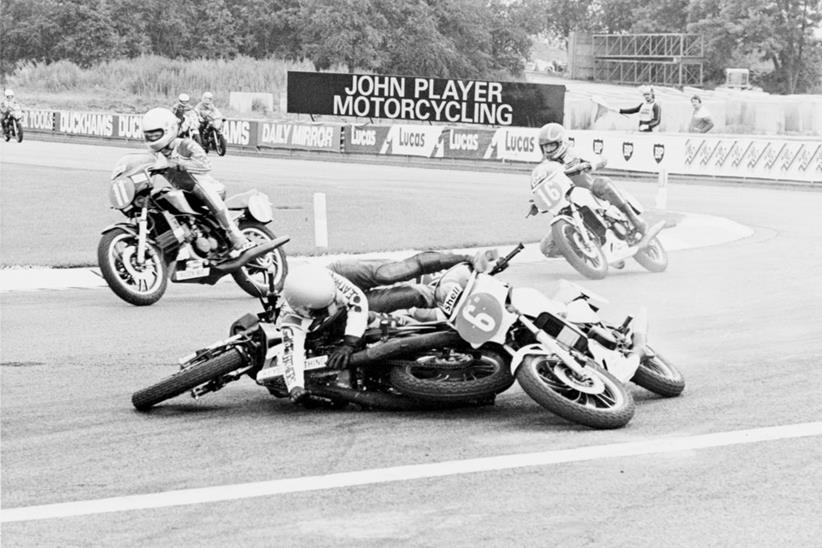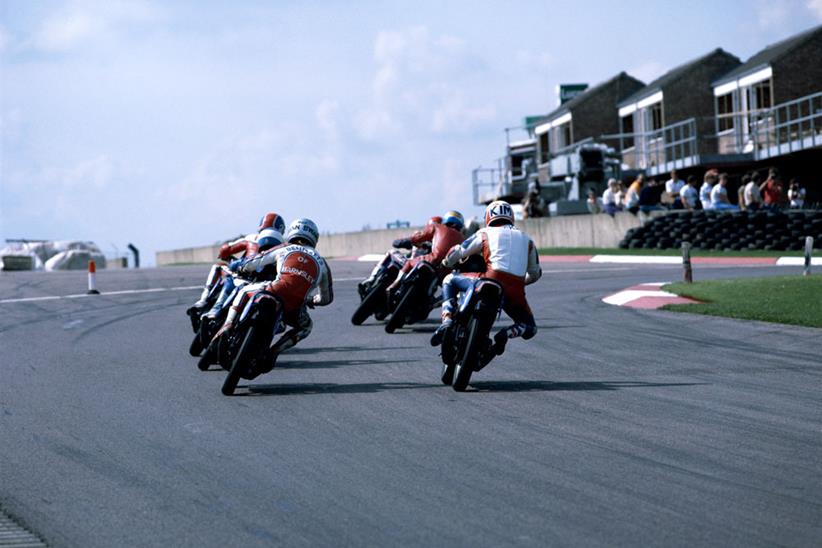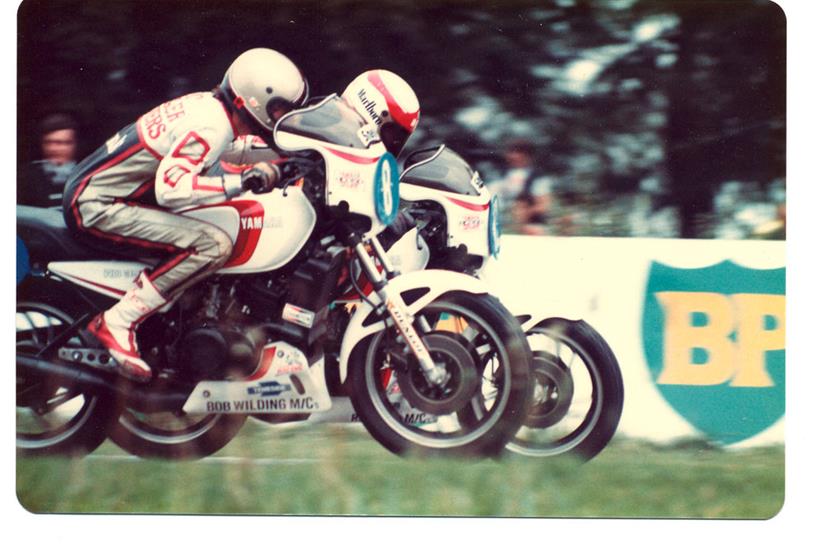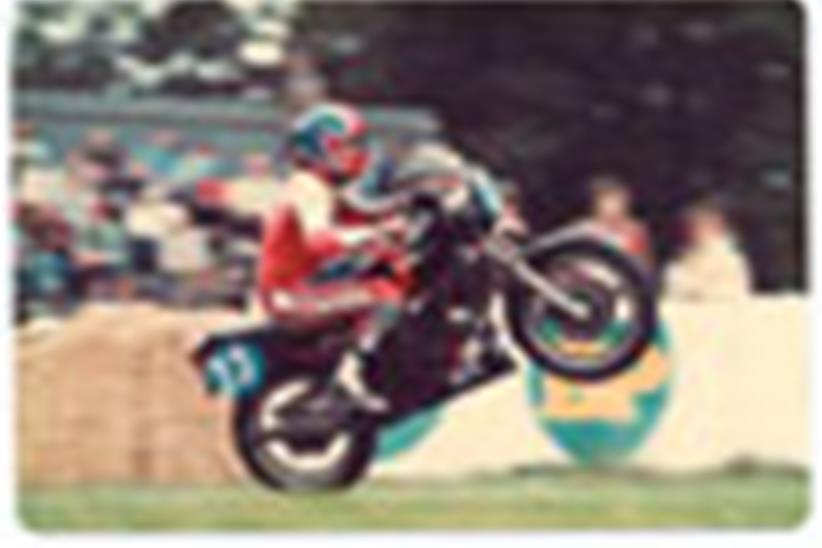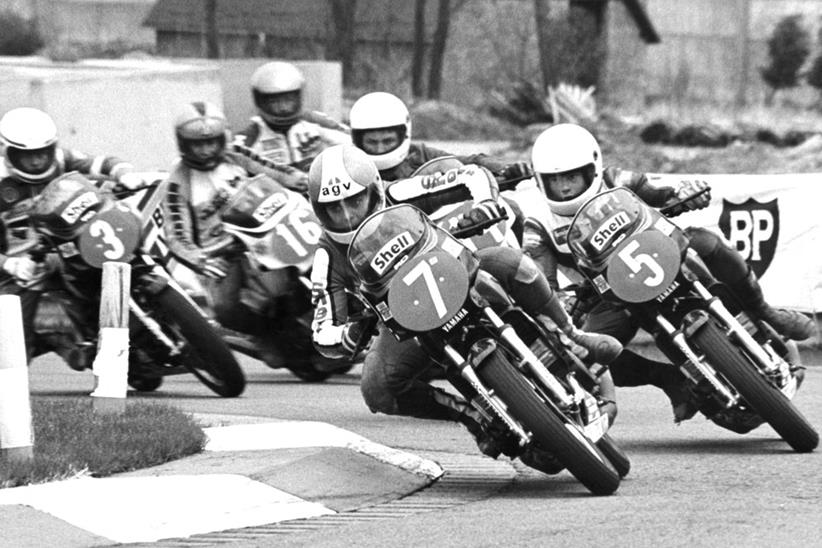Pro-Am: “We didn’t really care if we died”
Flicking kill switches. Kicking rivals. Hanging on to grab rails. Pushing riders off the track. It’s 1981, so it must be the Yamaha 350LC Pro-Am race series
![]()
![]() ndy Smith
ndy Smith
Then: marketing man for TW Promotions
Now: Vice President Marketing and Sales, Yamaha Europe
“In the late 1970s I worked for TW Promotions doing film shows to promote motorcycling. We’d go into cinemas, civic halls, town halls all round the country, turn up in the evening, set up a screen and get two, three, four hundred people per night. Yamaha came on board as a sponsor, and the idea for a race series of production RD350LCs came out of conversations in 1979 between TW Promotions and a chap working for UK Yamaha importers Mitsui called Lin Jarvis [now Yamaha’s MotoGP race team manager and Valentino’s boss]. The ACU got involved in sanctioning the series, and knew a TV company who’d get it on the screen.
“So you got all these guys saying, ‘Yes, let’s do this’. It hadn’t been done before – the first full production, no modifications, one-brand race series where the bikes belonged to and were maintained by the organisers.
“We should’ve known what was coming when we had a running-in session at Donington, with the bikes ridden by us, the promoters, and anyone we could rope in. On the first session, first lap, three people went off at the first corner.
“I remember loading the truck for the first round at Donington in 1981. We’d miscalculated the space so we had to hire another truck. We took 36 bikes to each meeting, including four spare bikes. In the end we bought our own transporters.
“We simply arrived at the circuit with the bikes, unloaded them, gave them numbers, the keys were pulled out of a hat, and at the end of the racing we put them all back in the truck and took them back to Yamaha in Chessington, where we repaired them for the next race.”
![]() Don Morley
Don Morley
Then: official Pro-Am photographer
Now: retired
“It was absolutely head-banging. We’d never seen anything like it before or since. Because the bikes were identical, and because you’ve suddenly got a class of rider who were very young, they had no fear, they had no financial involvement, so crashes were numerous – and who cared?
“I’d look through the lens and think, ‘I’ve never seen anything like this’. At the start you’d have six bikes all going into the first corner alongside each other and by the time they came round the last bend on the last lap they’d all get tangled up together and someone completely different would win. It was just so, so close. And crashes were many, but I don’t remember anyone getting hurt. Not seriously.”
![]() Niall Mackenzie
Niall Mackenzie
Then: aspiring club racer
Now: retired Grand Prix rider
“It was a brilliant series. It made my career, certainly; made my life, really.
“The series started in 1981 and I did a one-off wild card, and I was in it full time in 1982 and 1983. It carried on for a year after that but like all one-make series it got watered down. But the first three years were massive – it was all on TV, there were some big stars in it and the money was good.
“I’d just started racing on a 350LC. It was a dream to get in the Pro-Am, but there was no opportunity; you were invited by the organisers. The ACU picked ten established names and Yamaha picked ten rookies who were hot prospects at club level.
“There was a round at Knockhill that year, and the dealer who sponsored me persuaded the organisers to let me have a go. I started from the back of the grid and finished fifth. It was everything I dreamed it would be: free bike, free racing, bit of prize money. But that was it.
“At the start of 1982 I heard about a pre-season launch at Oulton Park. I jumped in a van and went down, uninvited. But I pleaded, and they gave in. I went out and was as quick as anyone. A week later I got a letter saying I was in. It was just fantastic.
“In ’82 I won some races, crashed a bit and was fifth overall. The next year was my best; I fought for the championship and finished second. I won quite a few races, including a one-off at Donington called the Pro-Am World Cup: ten of our best guys and ten foreigners.
“When you’re a teenager anything goes. We didn’t really care if we died racing. We just loved racing, so anything went. If there was a gap you let the brakes off; it was more like stock car racing, just ramming into each other. It was stuff you wouldn’t dream of doing now – hitting kill switches, pulling out ignition keys – you’d be slipstreaming another rider along a straight and with your left hand you’d grab onto their grab rail and slingshot yourself past.
“Thing was, we were all hairy-arsed council kids and it was free bikes, nobody cared if you crashed, there was no budget, no briefing where you were told not to do anything daft. It was a free-for-all.
“Fortunately the bikes crashed quite well, but they did get spannered. It was carnage. So you had to be a little bit clever. There were a few nutters who crashed every time. I was brave but I also tried to be smart when I could as well. I still wanted to get a result and make a name for myself.
“The atmosphere was great, because we all couldn’t believe what we were getting. It was like high-fiving each other before we went out, saying let’s go out and put on a show, let’s entertain everyone. There were no hard feelings, no bad atmospheres, it was just a laugh – serious on track, but a good time off it.
“It was a great springboard for me. Midway through 1983 a company called Armstrong who built racebikes signed me as a development rider off the back of my Pro-Am rides. They offered me a contract in 1984. One of the clauses was I couldn’t do the Pro-Am because they didn’t want to risk me. So I rode for Armstrong for four years, getting into 250 GPs in 1985 and 1986, which took me into a different world.”
![]() Paul Gott
Paul Gott
Then: spectator and amateur photographer
Now: banker
“I was into photography and bike racing. I’d follow the MCN Superbike series to Snetterton, Cadwell, Brands – all round the country. In 1980 I bought an RD250LC, the smaller version of the bikes they used for the Pro-Am series – so I was interested because they were racing a bigger version of my bike.
“I remember watching at Brands Hatch as the bikes all piled into Druids, four or five abreast. Crashes were all par for the course and it was all very close racing. Watching at Cadwell was a great place to take pictures – the Pro-Am bikes turned it into a wheelie competition. These were all young guys keen to make their mark. It certainly looked like it was a case of leave your brain in the paddock and go and race.”
![]() Mike Capon
Mike Capon
Then: club racer
Now: builds road and race shocks at the Shock Factory
“Pro-Am involved me falling on my head rather a lot. At Mallory in 1982, I had a famous crash you can still see on Youtube (look up Mallory Pro-Am). In practice my bike was slow – there were slow ones and quick ones. So I took to Yamaha and said, ‘Please, it’s got no midrange and it’s really, really rich. Can you drop the needles?’ They shouldn’t have done it but they did.
“So I got a flier and led the first lap with 23 other mental cases behind me. And because my bike was so slow in practice, coming out of the Bus Stop I’d been at full throttle and Devil’s Elbow was flat. But not with the bike working properly, it wasn’t. I lost the back, then the front, then both at once.
“The bike didn’t hurt me much – it was actually the other lad in the accident, Paul Tinker, riding over my head. It wasn’t the nicest thing to do but I don’t think he had much choice – I put my head in front of his bike.
“I broke a lot of bikes in 1982. I fell off at Mallory, ended up in the cabbages at Snetterton, crashed at Barn at Cadwell with Steve Chambers… I remember sitting on the fence with him, with two bent bikes. He was playing about with a bit of collarbone sticking out of his shoulder. And I can remember Alan Carter looping it on the grid at Knockhill. He was such a hooligan as a kid. Obviously he got smart because he won the French GP on a TZ250 a year later, but to start with he was a complete lunatic. It was max throttle, ping clutch, end of race.
“There weren’t many big injuries. And it was good-natured. But it got serious when the flag dropped because the stakes were high. We wanted to win the prize money so we could run our proper race bikes. It was quite mercenary. You got £500 for a win; I was working nights in a car factory on £80 a week, so that was a lot.
“At the start of 1983 the riders were invited to Oulton to ride the new bikes. Brand new, never been run. They said right, we need to run the bikes in. Just ride round slowly. Four laps in, Niall Mackenzie completely destroyed one of them. It was a big, big accident. Bet he doesn’t tell you that! But what did they expect?”
![]() Alan Carter
Alan Carter
Then: racing prodigy
Now: retired
“You put your hand in and pulled your key out. That’s how it was supposed to be but I cheated a little bit – sometimes I’d get the key to my preferred bike and have the key already in my hand when I put my hand in the hat. I wouldn’t call it cheating, I’d call it bending the rules. I was a devious little bastard, but in a charming manner.
“The LC in 1981 was better than the YPVS. The LC was on rails. People complained but I thought they were fantastic and the tyres were great. Then in ’83 they brought out the Powervalve and that thing just weaved everywhere. It was really unstable and just didn’t steer.
“I don’t think I ever fell off – maybe once, on cold tyres in practice at Donington. But you always had the ones who were really fucking mental, they were going to crash out anyway. My philosophy was to do the good times in practice and then you knew you’d be there or thereabouts. The only thing you could change on the bike was the gear lever – they had a short one and a long one. Apart from that they were supposed to be the same but they weren’t. You had fast ones and slow ones.
“For me, the Pro-Am didn’t give me a big break because my dad was a millionaire and I had everything. But it was good publicity and also it gave me hard racing against tough kids who wanted it bad. I learned from it. And you’d get Barry Sheene commentating on the telly saying I was a future world champ. But I never settled. I was in one series, and then something better came along so I did that.
“I won lots of races but I never actually won a championship because I just kept stepping up. I was the youngest ever national winner, then I won an international race and became the youngest ever international race winner. Then I won a GP and became the youngest ever GP winner. It just happened. You didn’t think about next week or next year. It was brilliant fun and the paddocks were fantastic. You could take the piss, have a beer, chase the girls, whatever.
“I love motorbikes. My life and my passion. But politics get involved and things happen and you think, ‘I’ve had enough of this’, and you quit. That’s what happened to me. By 28 I just didn’t want it any more. So I stopped.”
![]() Ronnie Weir
Ronnie Weir
Then: spectator and amateur photographer
Now: safety engineer
“I used to shoot racing pictures and had a weekly column in the Edinburgh Evening News. I knew Niall Mackenzie, who’d just started racing up in Scotland. I was covering another race in Ireland and I sat down to watch this Pro-Am race from Donington on TV and suddenly, bloody hell! There was Niall and he was in second place or something. And it was seven laps of murder! And an amazing array of talent – quality stuff. And any one of them could win. But there were loads of crashes – the road tyres would lose it after a couple of laps, the suspension would go off. It was amazing.
“If you got an invite to the Pro-Am you went. It was a big thing. Today, you can’t imagine a Pro rider putting it on the line against Am riders – guys like Steve Parrish, Rob MacElnea and Roger Burnett were on a hiding to nothing because who wants to be beaten by so-called amateurs? And it was special because everything was paid for, so they felt like works riders. There’s a big thing about nostalgia for that era, but I never expected it to be so popular 30 years down the line.”
![]() Roger Atyeo
Roger Atyeo
Then: Which Bike? magazine assistant editor
Now: Australian journalist
“I arranged a deal for Which Bike? to pay £3000 per season in 1983 and ’84 to get stickers on the bikes. That was a fair chunk of money back then, but the TV coverage was great. The series was called the Wrangler Which Bike? Pro-Am. The first year we were involved Carter went on to win the French GP, so that was all good. It was hugely successful, the best one-make series there’s been. The racing was bonkers, and the format was unique. No-one knew which bike they would get and it was so unpredictable. The only constant was whoever led the series had the bike painted in Wrangler/Which Bike? colours. I’ve been to loads of races over the years and it’s the only one where I’d watch the start through my fingers, like a horror movie. Going into Redgate they were ten abreast. And they all loved it. And it didn’t bother them because they didn’t have to foot the bill for repairs. I said to Rob Mac, ‘How come you aren’t doing it any more?’ and he said, ‘No, too rough for me’. Roger Burnett, he declined after one race. It scared the crap out of a lot of top riders.”
![]() Steve Chambers
Steve Chambers
Then: aspiring racer
Now: lecturer for Siemens plc
“I joined the series in 1982, and we had brand new LCs. In 1983 we got the new YPVS – a bit quicker but the suspension wasn’t so good – and we kept them for the last year in 1984. There was a noticeable difference between some of the bikes by then – you could get a pig of a bike 5mph slower.
“It was scary at times. There was a period when there was a lot of weaving and swerving going on. I’m not saying it was deliberate, but I remember Niall pulling across me at Donington and taking out my front wheel – I ended up rolling down the track. I wasn’t too happy at the time I suppose, but there was rivalry on the track and smiles afterwards.
“My memories are of how much fun it was. It was very competitive and the guys in it were all quick. The one guy I felt could beat me on his day was Alan. All the others I felt I could beat, but Alan was the outstanding rider. Niall of course went on to success, but Alan was the one who could’ve gone on further.
“In one of the televised races at Donington, Ray Swann crashed at the chicane. He lay very still as if unconscious. He was completely fine and knew he was safe, but also realised the cameras would be on him. So he got a few seconds of TV time with concerned commentators!
“The European events always got me fired up. In 1982 they got the best riders from Europe together at Brands – the Euro Pro-Am. I won it, Alan Carter was second. Next year they did the same thing at Hockenheim; Graham Cannell won it, I was second. In ’84 there was a round at Circuit Carole in Paris. My bike was a pogo stick on wheels and there was no spare – basically the budget was finished.”
Words Simon Hargreaves Photos Bauer Archive, Don Morley, Paul Gott and Ronnie Weir
